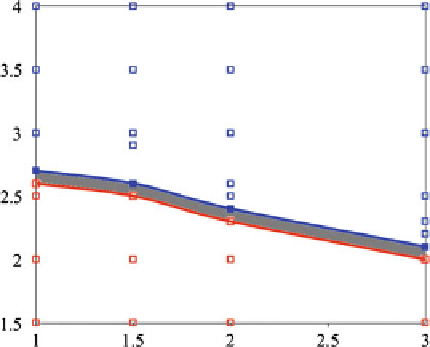Environmental Engineering Reference
In-Depth Information
Fig. 7
Stability map of the
flow past a pair of magnetic
obstacles side by side. The
gray
strip displays the
transition zone between
steady and time-dependent
flow.
Re
Vortex shedding
=
1,000
Steady vortex
pair
D
4 Concluding Remarks
In this work, we have investigated numerically using a Q2D model the flow past a
pair of magnetic obstacles side by side at a fixed Reynolds number,
Re
1,000.
We analyzed the coupling of the wakes behind the magnetic obstacles under vortex
shedding conditions for different values of the dimensionless separation distance,
namely,
D
=
1, 1.5, 2, and 3. From the numerical velocity field, Lagrangian tra-
jectories were obtained which allow to visualize different flow structures. A strong
coupling was found for
D
=
1 where the pair of obstacles act as a large magnetic
obstacle that produces a single wake whose dominant frequency is close to the one
found experimentally (Honji and Haraguchi
1995
) and almost coincide with that of
the flow past a solid cylinder. A more complex pattern was found for
D
=
5 where
an intermediate coupling leads to a bistable regime, characterized by a biased flow
with asymmetric flow structures. Finally, a weaker coupling of the wakes was found
for
D
=
1
.
3, where well defined in phase wakes are observed. In general
terms, it can be stated that the flow past a pair of magnetic obstacles side by side
presents similar regimes as those observed in the wakes created by a pair of solid
cylinders.
=
2 and
D
=
Acknowledgments
T
his work has been supported by CONACyT, Mexico, under project 131399.
J. Román also acknowledges a grant from CONACyT. The authors are grateful to Saul Piedra for
providing the subroutine for the particle tracking that we present in this article.

Search WWH ::

Custom Search